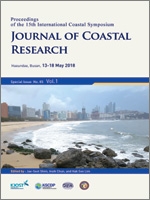Lee, S.C.; Choi, J.Y.; Park, K.S.; Kim, S,-S.; Kim, S,J., and Jun, K.C, 2018. Use of Optical Video Imagery to Improve Wave run-up Prediction Accuracy. Assessing the economic value of beach restoration: Case of Song-do Beach, Korea. In: Shim, J.-S.; Chun, I., and Lim, H.S. (eds.), Proceedings from the International Coastal Symposium (ICS) 2018 (Busan, Republic of Korea). Journal of Coastal Research, Special Issue No. 85, pp.1271–1275. Coconut Creek (Florida), ISSN 0749-0208.
On the eastern coast of Korea, wave run-up occurrences have induced several accidents causing damage to human life. To prevent the occurrence of casualties in coastal areas, the breakwater disaster alert system has been employed, which issues a warning based on an estimate of the incident-wave height. This estimate of wave height is obtained through numerical solution of an empirical formula derived from the relationship between incident-wave and run-up heights. By utilizing the empirical formula and wave forecast, the breakwater disaster alert system has been successfully employed in the Sokcho, Samcheok, and Jumunjin regions in the Republic of Korea. This study proposes wave height-based modifications to the above empirical formula through use of additional datasets recorded during the period from November 2016 to June 2017. These datasets concerning wave height and wave period were recorded at the Jumunjin ports by P-gage. Simultaneously, run-up heights at this port was estimated via video images. Using the recorded dataset, a number of high run-up events were selected, and from the video recorded for each of these events, individual image frames were sequentially sampled and rectified into real world coordinates. Run-up properties estimated from the extracted signal record for run-up reference level points were combined with measurements of incident waves in order to derive an empirical relation between incident waves and run-up heights. By employing the modified empirical formula, accuracy in run-up height prediction has been found to be improved.





